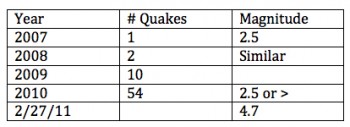
The U.S. has seen a precipitous increase in shale oil and gas extraction over the past decade that would be impossible without the coupling of two old technologies, horizontal drilling and hydraulic fracturing aka fracking. The courting and subsequent marriage of these two technologies took place in my Wise County Texas backyard.
Areas in the middle of America—Arkansas, Colorado, New Mexico, Ohio, Oklahoma, Texas and Virginia—that have been usually earthquake free have seen a significant increase in earthquakes during the past decade, which relates to the increase in fracking and injection of massive amounts of flowback and produced water.
“A naturally-occurring rate change of this magnitude is unprecedented outside of volcanic settings or in the absence of a main shock, of which there were neither in this region” (Ellsworth et al, 2012). Link
A new study refers to the shale oil and gas boom as “fracking industrialization.” I like that term. Unless otherwise noted, I used the study Fracking Industrialization and Induced Earthquakes: The Mechanisms that Connect the Disposal of Fracking Wastewater into Deep-Injection Wells to a Significant Increase in Midcontinent Seismic Activity throughout this blog post.
Updated with link to full study.
Fracking requires injection and injection causes earthquakes.
We have known since the 1960’s that injection causes earthquakes. Fracking or injection under very high pressure of millions of gallons of water, a proppant and thousands of gallons of chemicals is required to produce oil and or gas from shale. Each fracked shale well, in turn produces wastewater that, 95% of the time, requires injection into a disposal well. Even CO2 injection for enhanced recovery from shale oil and gas wells has led to 48 earthquakes in Snyder,Texas.
According to former Mobil V.P. Louis Allstadt, Wells that are fracked produce “50 to 100 times more” wastewater than conventional wells.
So when you talked about “the race for what’s left,” that’s what’s going on. Both the horizontal drilling and fracturing have been around for a long time. The industry will tell you this over and over again – they’ve been around for 60 years, things like that. That is correct. What’s different is the volume of fracking fluids and the volume of flow-back that occurs in these wells. It is 50 to 100 times more than what was used in the conventional wells. Former Mobil VP warns of fracking and climate change.
As of November 2013, approximately 100,000 fracking wells have been drilled or permitted in the U.S. In 2012, 22,326 wells were drilled and fracked in the U.S. 60% of those were in Texas. More than 95% of the wastewater from fracked wells is disposed of in injection wells because that is the cheapest way to get rid of it but we don’t know if that’s the safest way.
Industry knows that the disposing of the massive amounts of toxic and radioactive waste is one of the biggest challenges of fracking. Brad Miller, General Manager of Regulatory Affairs for Anadarko Petroleum, expressed this at the industry “psyops” conference I attended and taped in 2010. In his presentation, Miller acknowledged that waste management is the biggest challenge for fracking.
Fracking is a farce we need to take care of waste water. We need to get ahead of this as an industry. EPA is going after this now. What happens to that frack water?
You can read the rest of this post on Daily Kos.
Media Advisory: Railroad Commissioner David Porter Hosts Town Hall Meeting to Discuss Earthquakes
Texas Railroad Commissioner David Porter will host a town hall meeting to discuss recent seismic occurrences in the North Texas area, at which he will listen to resident’s concerns and outline what he plans to do as Texas Railroad Commissioner. Other state and local officials will be in attendance.
Date: Thursday, January 2, 2014
Time: 5:00 p.m. to 7:00 p.m. CST
Location: Azle High School Auditorium, 1200 Boyd Rd, Azle, TX 76020
Press contact: Katie Carmichael, 512-463-8870
About Sharon Wilson
Sharon Wilson is considered a leading citizen expert on the impacts of shale oil and gas extraction. She is the go-to person whether it’s top EPA officials from D.C., national and international news networks, or residents facing the shock of eminent domain and the devastating environmental effects of natural gas development in their backyards.
- Web |
- More Posts(5121)